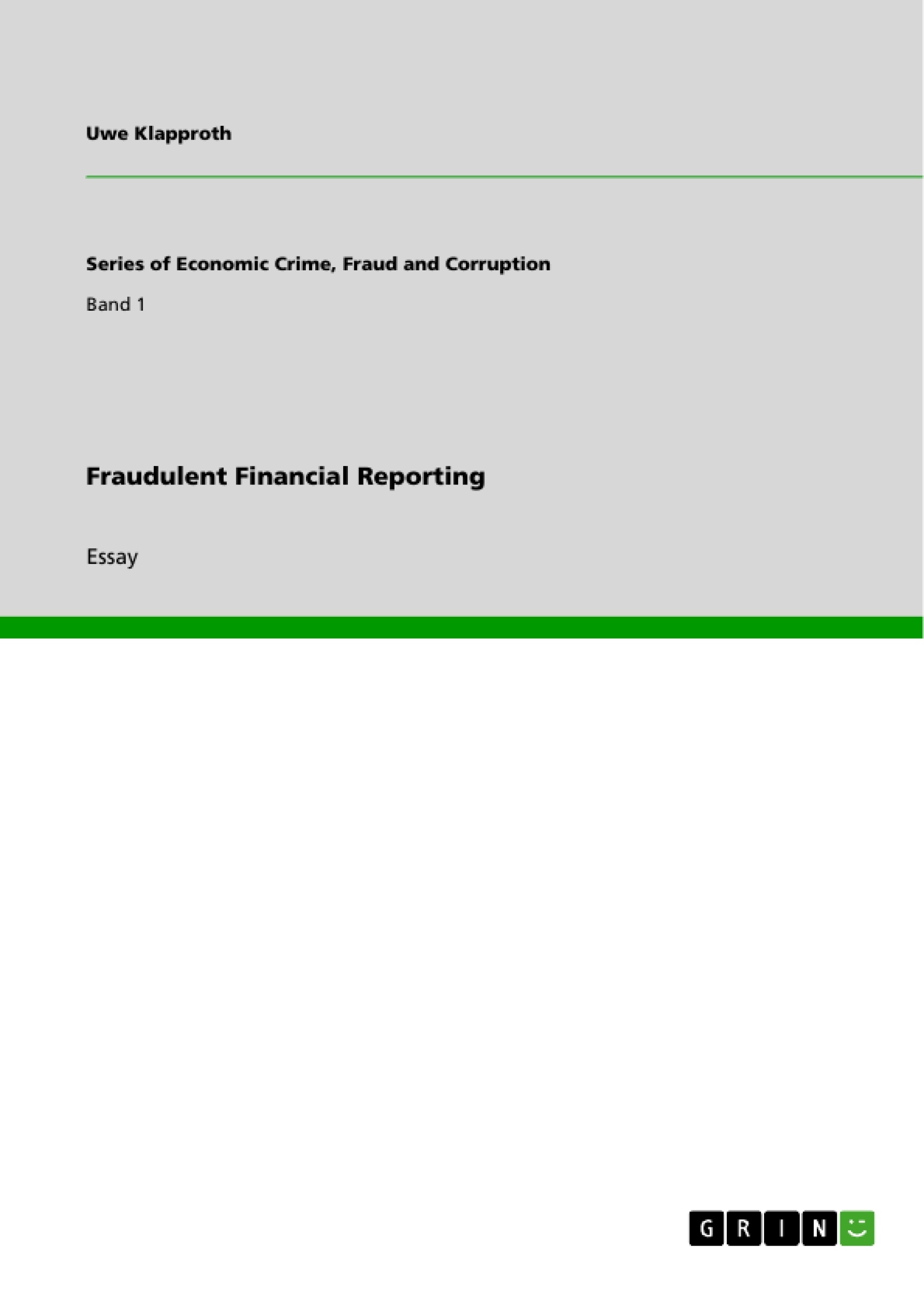Extracto
INTRODUCTION: CASE OF FINANCIAL FRAUD
Fraudulent financial reporting is the most costly type of the three types of occupational fraud . Recent surveys found that financial fraud is substantial and affecting the relevance and reliability of financial statements; potentially causing long-term damage to the usefulness of financial statements (Schipper & Vincent, 2006). According to the Association of Certified Fraud Examiners (ACFE) there are three types of occupational fraud (ACFE, 2006). The three categories are asset misappropriations, corruption, and fraudulent financial results, and this report focuses on the last item, financial reporting fraud.
According to the ACFE 2006 survey, ten percent of reported occupational fraud cases are financial statement fraud. This is not the most common type of occupational fraud but according the certified fraud examiners (CFEs) it is the most costly; the median loss due to financial statement fraud was USD2 million while the median loss for asset misappropriation was USD150,000 - thirteen times greater (ACFE, 2006). According to the ACFE 2006, survey the most common manipulations of fraudulent financial reporting are:
(a) reporting fictitious or overstated revenues;
(b) concealing or understating liabilities or expenses;
(c) timing differences recording revenues or expenses in the incorrect period;
(d) improperly valuing assets; or
(e) failing to disclose significant information (ACFE, 2006; Buckhoff, 2001).
PREVALENCE OF FINANCIAL FRAUD IN ORGANISATIONS
Due to heightened awareness of and increased interest in fraudulent financial reporting, many in the field of accounting and financial fraud have conducted their own research. PricewaterhouseCoopers (2006) 2005 survey found a 140% increase in financial fraud from 2003 and that the average financial fraud was USD1.7 million. This is consistent with KPMG’s 2003 survey, which stated that FFR had increased in rate of occurrence from three percent to seven percent at an estimated cost of USD250 million (KPMG Forensic, 2003). KPMG compared the USD250 million in total losses to medical insurance fraud, which cost USD33.7 million (KPMG Forensic, 2003). The ACFE (2006) stated US organisations lost 5% of annual revenues due to fraud. When applied to the estimated 2006 Gross Domestic Product the 5% figure translates to approximately USD652 billion in fraud losses (ACFE, 2006). In addition, the ACFE (2006) study found 30% of occupational fraud was committed by employees in the accounting department and 20% were committed by upper management or executives. These violations are material, increasing in frequency, and have a significant economic impact on stakeholders, as financial fraud has cost investors more than USD100 billion over the past two years (Rezaee, 2002). As a result, financial statement reliability is being compromised and decision usefulness eroded.
Financial fraud may range from simple financial schemes to more highly complex accounting techniques employed specifically to deceive investors that typically might contain intentional misstatements of the true financial condition of the firm (Lomax, 2003). There are several examples of the methods used in financial reporting scandals that misstate financial reports. The most common forms of fraudulent reporting techniques include
(a) fictitious revenues,
(b) recording revenues prematurely,
(c) overstatements of revenue,
(d) overstatements of accounts receivable,
(e) recording fictitious assets,
(f) capitalising expenses as noncurrent activities that understates expenses and falsely increases earnings, and
(g) understatement of expenses or other liabilities (Beasley, Carcello, Hermanson, 1999).
A review of the literature regarding fraudulent financial reporting showed emerging themes, that fraud is sometimes difficult to detect, difficult to eliminate, and that no company is immune from financial fraud (Black, 2003; Wells, 2007). Studies have shown that anyone may commit fraud, and fraud is a growing problem worldwide (ACFE, 2006; Peterson & Zikmund, 2004; Wells, 2007).
In the US 2003 national survey of 459 public companies with annual revenues of at least USD250 million, state and federal governmental agencies, KPMG Forensic (2003) found 344 (75%) of the companies surveyed reported that fraud was on the increase. While employee fraud might be the most prevalent form of fraud, fraudulent financial reporting and medical/insurance fraud are more costly (KPMG Forensic, 2003). The greatest impact of financial fraud using relative scaling occurred with smaller businesses (Adams et al, 2006; ACFE, 2006; Peterson & Zikmund, 2004).
COST OF FINANCIAL FRAUD
In a KPMG study of 459 public companies with annual revenues of USD250 million or more, state, and federal government agencies, the average cost of financial reporting fraud reported was USD258 million (KPMG Forensic, 2003). A more recent expanded study by other researchers consisted of five sections of 77 questions was distributed to 11,112 Certified Fraud Examiners (ACFE, 2006). From this population, there were 1,134 responses used in the report, which represented a 10.21% response rate. These respondents reported on actual fraud cases from 2004 to 2006, whereby the median loss for financial statement fraud was reported at USD2 million (ACFE, 2006).
Researchers of this same organisation reported in its 2004 Report to the Nation on Occupational Fraud and Abuse that the estimate of the typical company in the U.S. loses about 6% of its earnings to fraud (ACFE, 2006). The percentage of losses translates to approximately USD660 billion when applying the Gross Domestic Product for 2003 (ACFE, 2004). Another study on the detection and prevention of financial crime estimated the cost for this type of crime ranges from 1% to 6% of corporate earnings and that not much is known about the conditions within the companies that can be taken to reduce this cost (Schnatterly, 2003).
Because not all fraud cases are reported to the SEC or to prosecutorial authorities, the absolute true cost of fraud is not known. For example, the top four reasons why organisations decided not to prosecute the perpetrators of fraud were
(a) fear of the negative publicity,
(b) discipline was handled internally,
(c) a private settlement was reached, and
(d) the cost was prohibitive to pursue further (ACFE, 2006).
[...]
- Citar trabajo
- Uwe Klapproth (Autor), 2010, Fraudulent Financial Reporting, Múnich, GRIN Verlag, https://www.grin.com/document/175424
Así es como funciona






















Comentarios